
A tokamak is a device which uses a powerful magnetic field to confine plasma in the shape of a torus. The tokamak is one of several types of magnetic confinement devices being developed to produce controlled thermonuclear fusion power. As of 2016, it was the leading candidate for a practical fusion reactor. The word "tokamak" is derived from a Russian acronym meaning "toroidal chamber with magnetic coils".

A fusor is a device that uses an electric field to heat ions to a temperature in which they undergo nuclear fusion. The machine induces a potential difference between two metal cages, inside a vacuum. Positive ions fall down this voltage drop, building up speed. If they collide in the center, they can fuse. This is one kind of an inertial electrostatic confinement device – a branch of fusion research.
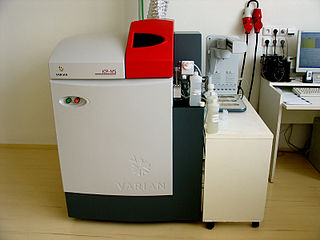
Inductively coupled plasma mass spectrometry (ICP-MS) is a type of mass spectrometry that uses an inductively coupled plasma to ionize the sample. It atomizes the sample and creates atomic and small polyatomic ions, which are then detected. It is known and used for its ability to detect metals and several non-metals in liquid samples at very low concentrations. It can detect different isotopes of the same element, which makes it a versatile tool in isotopic labeling.

Fusion power is a proposed form of power generation that would generate electricity by using heat from nuclear fusion reactions. In a fusion process, two lighter atomic nuclei combine to form a heavier nucleus, while releasing energy. Devices designed to harness this energy are known as fusion reactors. Research into fusion reactors began in the 1940s, but as of 2024, no device has reached net power, although net positive reactions have been achieved.
This timeline of nuclear fusion is an incomplete chronological summary of significant events in the study and use of nuclear fusion.

The Joint European Torus (JET) was a magnetically confined plasma physics experiment, located at Culham Centre for Fusion Energy in Oxfordshire, UK. Based on a tokamak design, the fusion research facility was a joint European project with the main purpose of opening the way to future nuclear fusion grid energy. At the time of its design JET was larger than any comparable machine.
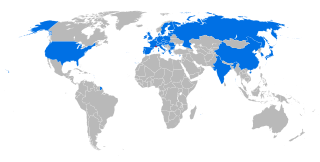
ITER is an international nuclear fusion research and engineering megaproject aimed at creating energy through a fusion process similar to that of the Sun. Upon completion of construction of the main reactor and first plasma, planned for late 2025, it will be the world's largest magnetic confinement plasma physics experiment and the largest experimental tokamak nuclear fusion reactor. It is being built next to the Cadarache facility in southern France. ITER will be the largest of more than 100 fusion reactors built since the 1950s, with ten times the plasma volume of any other tokamak operating today.

Inertial electrostatic confinement, or IEC, is a class of fusion power devices that use electric fields to confine the plasma rather than the more common approach using magnetic fields found in magnetic confinement fusion (MCF) designs. Most IEC devices directly accelerate their fuel to fusion conditions, thereby avoiding energy losses seen during the longer heating stages of MCF devices. In theory, this makes them more suitable for using alternative aneutronic fusion fuels, which offer a number of major practical benefits and makes IEC devices one of the more widely studied approaches to fusion.

The gridded ion thruster is a common design for ion thrusters, a highly efficient low-thrust spacecraft propulsion method running on electrical power by using high-voltage grid electrodes to accelerate ions with electrostatic forces.
Plasma acceleration is a technique for accelerating charged particles, such as electrons or ions, using the electric field associated with electron plasma wave or other high-gradient plasma structures. These plasma acceleration structures are created using either ultra-short laser pulses or energetic particle beams that are matched to the plasma parameters. The technique offers a way to build affordable and compact particle accelerators.
The Small Tight Aspect Ratio Tokamak, or START was a nuclear fusion experiment that used magnetic confinement to hold plasma. START was the first full-sized machine to use the spherical tokamak design, which aimed to greatly reduce the aspect ratio of the traditional tokamak design.
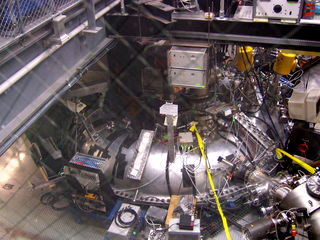
The Madison Symmetric Torus (MST) is a reversed field pinch (RFP) physics experiment with applications to both fusion energy research and astrophysical plasmas.
Neutral-beam injection (NBI) is one method used to heat plasma inside a fusion device consisting in a beam of high-energy neutral particles that can enter the magnetic confinement field. When these neutral particles are ionized by collision with the plasma particles, they are kept in the plasma by the confining magnetic field and can transfer most of their energy by further collisions with the plasma. By tangential injection in the torus, neutral beams also provide momentum to the plasma and current drive, one essential feature for long pulses of burning plasmas. Neutral-beam injection is a flexible and reliable technique, which has been the main heating system on a large variety of fusion devices. To date, all NBI systems were based on positive precursor ion beams. In the 1990s there has been impressive progress in negative ion sources and accelerators with the construction of multi-megawatt negative-ion-based NBI systems at LHD (H0, 180 keV) and JT-60U (D0, 500 keV). The NBI designed for ITER is a substantial challenge (D0, 1 MeV, 40 A) and a prototype is being constructed to optimize its performance in view of the ITER future operations. Other ways to heat plasma for nuclear fusion include RF heating, electron cyclotron resonance heating (ECRH), ion cyclotron resonance heating (ICRH), and lower hybrid resonance heating (LH).
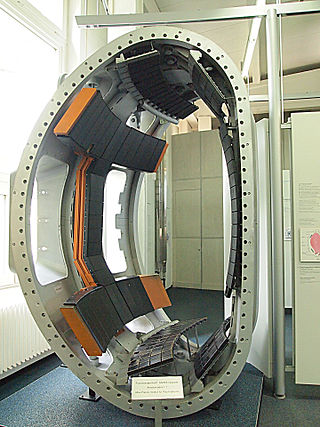
ASDEX Upgrade is a divertor tokamak at the Max-Planck-Institut für Plasmaphysik, Garching that went into operation in 1991. At present, it is Germany's second largest fusion experiment after stellarator Wendelstein 7-X.
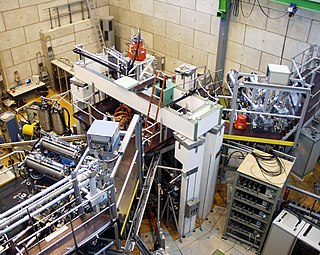
The tokamak à configuration variable is an experimental tokamak located at the École Polytechnique Fédérale de Lausanne (EPFL) Swiss Plasma Center (SPC) in Lausanne, Switzerland. As the largest experimental facility of the Swiss Plasma Center, the TCV tokamak explores the physics of magnetic confinement fusion. It distinguishes itself from other tokamaks with its specialized plasma shaping capability, which can produce diverse plasma shapes without requiring hardware modifications.
The polywell is a proposed design for a fusion reactor using an electric and magnetic field to heat ions to fusion conditions.

Plasma-immersion ion implantation (PIII) or pulsed-plasma doping is a surface modification technique of extracting the accelerated ions from the plasma by applying a high voltage pulsed DC or pure DC power supply and targeting them into a suitable substrate or electrode with a semiconductor wafer placed over it, so as to implant it with suitable dopants. The electrode is a cathode for an electropositive plasma, while it is an anode for an electronegative plasma. Plasma can be generated in a suitably designed vacuum chamber with the help of various plasma sources such as electron cyclotron resonance plasma source which yields plasma with the highest ion density and lowest contamination level, helicon plasma source, capacitively coupled plasma source, inductively coupled plasma source, DC glow discharge and metal vapor arc. The vacuum chamber can be of two types - diode and triode type depending upon whether the power supply is applied to the substrate as in the former case or to the perforated grid as in the latter.
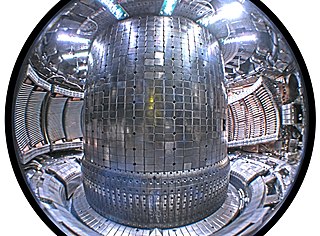
In nuclear fusion power research, the plasma-facing material (PFM) is any material used to construct the plasma-facing components (PFC), those components exposed to the plasma within which nuclear fusion occurs, and particularly the material used for the lining the first wall or divertor region of the reactor vessel.
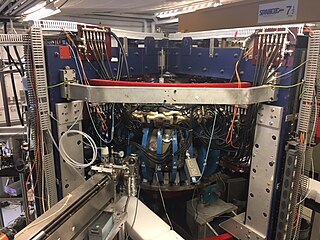
The Hybrid Illinois Device for Research and Applications (HIDRA) is a medium-sized toroidal magnetic fusion device housed in the Nuclear Radiation Laboratory and operated by the Center for Plasma-Material Interactions (CPMI) within the Department of Nuclear, Plasma and Radiological Engineering at the University of Illinois at Urbana–Champaign, United States. HIDRA had its first plasma at the end of April 2016 and started experimental campaigns by December of that year. HIDRA is the former WEGA classical stellarator that was operated at the Max Planck Institute for Plasma Physics in Greifswald Germany from 2001 to 2013.
Colliding beam fusion (CBF), or colliding beam fusion reactor (CBFR), is a class of fusion power concepts that are based on two or more intersecting beams of fusion fuel ions that are independently accelerated to fusion energies using a variety of particle accelerator designs or other means. One of the beams may be replaced by a static target, in which case the approach is termed accelerator based fusion or beam-target fusion, but the physics is the same as colliding beams.
















